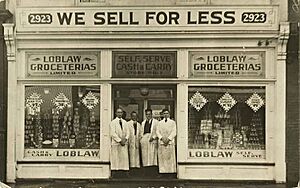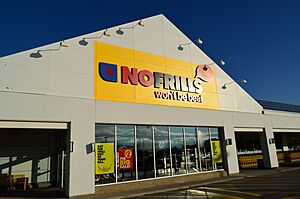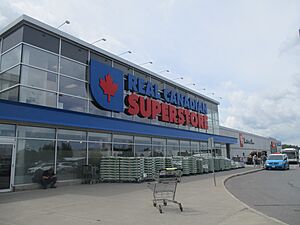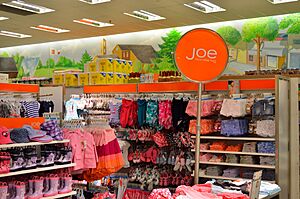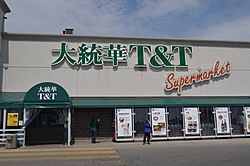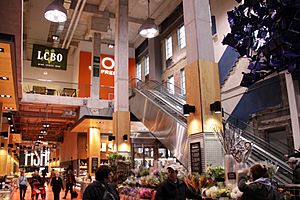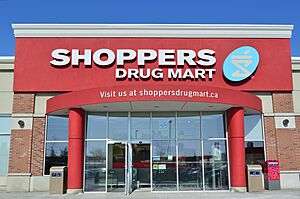Loblaw Companies facts for kids
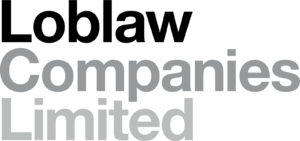 |
|
| Public subsidiary | |
| Traded as | TSX: L |
| Industry | Retail |
| Founded | Toronto, Ontario, Canada (1919) |
| Headquarters | Brampton, Ontario, Canada |
|
Key people
|
Galen Weston Jr. (Chairman and Director)
|
| Products | Apparel Cash and carry Discount store Hypermarket Supercentre Supermarket Superstore Warehouse club |
| Brands | See list |
| Revenue | |
|
Operating income
|
CA$3.342 billion (2022) |
| CA$1.994 billion (2022) | |
| Total assets | CA$38.147 billion (2022) |
| Total equity | CA$11.456 billion (2022) |
|
Number of employees
|
221,000 (2022) |
| Parent | George Weston Limited (52.2%; as of 2020) |
| Subsidiaries | Loblaws Atlantic Superstore Dominion Stores Extra Foods Fortinos Freshmart Maxi No Frills No Name President's Choice President's Choice Financial Provigo Real Canadian Liquorstore Real Canadian Superstore Shoppers Drug Mart / Pharmaprix SuperValu T & T Supermarket Valu-mart Your Independent Grocer Zehrs Markets |
Loblaw Companies Limited is a very large Canadian company. It owns many grocery stores, pharmacies, and even clothing brands. You might know some of their stores like Loblaws, Shoppers Drug Mart, or No Frills.
Loblaw also has its own popular brands for food, clothes, baby items, and more. Some of their most famous brands are President's Choice, No Name, and Joe Fresh. Loblaw is the biggest food seller in Canada.
The company is part of a larger group called George Weston Limited. This group is controlled by the Weston family. Galen Weston Jr. is the chairman of Loblaw's board of directors. He also leads the George Weston company.
Most of Loblaw's 221,000 employees are part of a union called the United Food and Commercial Workers. This helps make sure workers have fair conditions. Loblaw also has different food distribution centers across Canada. These centers help get food to stores in different regions.
Contents
- Loblaw's Story: A Canadian Retail Journey
- Starting with "Self-Serve" Stores
- Facing Tough Times: Depression and War
- Growing Bigger After the War
- Becoming Loblaw Companies Limited
- Challenges and Changes
- No Name and No Frills: Saving Money
- President's Choice: High Quality for Less
- Big Stores and Liquor Stores
- Growing Across Canada
- New Leaders and New Ideas
- Joe Fresh: Fashion in the Grocery Store
- Caring for the Environment
- T&T and Black Label: New Tastes
- Loblaw Store Names (Banners)
- Maple Leaf Gardens: A Historic Store
- Choice Properties: Real Estate
- Shoppers Drug Mart: A Big Partnership
- Images for kids
Loblaw's Story: A Canadian Retail Journey
Starting with "Self-Serve" Stores
In 1919, two friends, Theodore Loblaw and J. Milton Cork, opened the first Loblaw Groceterias store in Toronto. This store was special because it was "self-serve." Before this, you had to wait for a clerk to get your items. They would also weigh things like sugar and flour for you.
Loblaw and Cork wanted to make shopping cheaper. They decided to let customers pick their own items. Customers would then pay cash at a central counter. This new idea helped cut down on costs. They got the idea from a store in the United States called Piggly Wiggly.
Many people thought their idea wouldn't work. But Theodore Loblaw believed that people would like to carry their own groceries if it meant lower prices. The first store opened in June 1919. It had big signs saying "We Sell For Less." The stores were clean and well-lit, with clear prices.
Customers would grab a basket and walk around to pick their food. Then, they would pay at a checkout counter. This was a new way to shop for groceries. Even though fresh meat was not available at first, the stores became very popular.
Three years later, there were nine Loblaw stores in Toronto. The company also expanded into the United States. In 1928, Loblaw opened a huge new office and warehouse in Toronto. It cost CA$1.25 million and was very modern. It had its own railway tracks and big ovens for baking. It even had bowling lanes for employees!
Facing Tough Times: Depression and War
In 1929, another grocery chain, Dominion Stores, wanted to buy Loblaw. But then the Great Depression hit, and the deal didn't happen. Even with the tough economy, Loblaw kept growing. By 1930, they had 97 stores in Ontario.
In 1933, Theodore Pringle Loblaw passed away. He was known for his business success and for helping charities. After his death, J. Milton Cork took over the company.
During the 1930s, Loblaw started changing its stores into "Market Stores." These new stores had fresh meat and produce departments for the first time. This was a big change from the original self-serve idea. By 1936, more than half of their stores had these new departments.
In 1939, the stores officially changed their name to "Loblaws." They also started offering frozen foods, which was new in Canada. Loblaw even added cool features like automatic doors and air conditioning.
Growing Bigger After the War
After World War II, Loblaw started building new stores again. They added parking lots, which were important for people who drove cars. They also designed stores with "rear entrances" so shoppers could easily get to their cars.
In 1947, a big change happened. A Canadian businessman named W. Garfield Weston bought a large part of Loblaw. Weston already owned other businesses like bakeries. By 1953, Weston's company, George Weston Limited, had full control of Loblaw.
With Weston in charge, Loblaw grew very quickly. They bought other grocery chains across Canada and in the United States.
Becoming Loblaw Companies Limited

In 1953, Loblaw bought more stores in the U.S. and a chain called Power Supermarkets in Toronto. In 1956, the company officially became "Loblaw Companies Limited." This new name showed that it was a holding company for all its different stores.
Loblaw continued to expand, especially in Western Canada. They bought other companies like Atlantic Wholesalers. At its biggest, Loblaw Companies Limited was one of the largest grocery retailers in North America.
To keep customers, Loblaw tried different promotions. In the 1950s, they gave away cars at store openings! In 1959, they started "Lucky Green Stamps." Customers collected these stamps and could trade them for gifts. But by 1967, people felt the stamps made prices higher, so the program ended.
Challenges and Changes
In the 1960s, Loblaw made a lot of sales, but their profits went down. The company had grown too fast. Customers and experts were confused about how the company was organized.
By the early 1970s, Loblaw was in trouble. They had a lot of debt, and their stores needed updates. Sales were dropping fast. W. Galen Weston, Garfield Weston's youngest son, was asked to help. In 1972, he became the chief executive officer.
Galen Weston started by closing many stores that weren't making money. He also updated the stores that stayed open. He said, "As a 200 store chain, we didn't look very good. As a 100 store chain, we looked very good indeed."
In 1973, Weston hired a designer named Don Watt. Watt completely changed the look of Loblaw stores. He made the produce section bigger and moved it to the front. He used new colors and a new "L" logo. He also added big photos of fresh food. These changes made sales go up by 60 percent in just a few months!
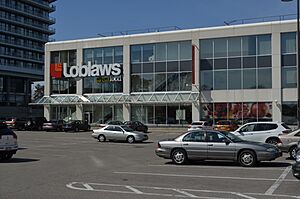
Loblaw also started a new advertising campaign with actor William Shatner from Star Trek. He told TV viewers that "More than the price is right...but by gosh, the price is right."
By the end of the 1970s, Loblaw Companies Limited was making money again. Many people called it a "classic turnaround story."
No Name and No Frills: Saving Money
Loblaw also worked on creating its own store brands. In 1978, they launched "No Name" products. These items came in simple black and yellow packages. They were much cheaper, saving customers 10 to 40 percent.
No Name products became very popular because prices were going up. People loved saving money. A year later, there were over a hundred No Name products.
Soon after, Loblaw opened a new type of store called No Frills. These stores were "box stores." Items were kept in their shipping boxes to save money. Customers had to pack their own groceries and bring their own bags. There were fewer items to choose from, but the prices were very low. The first No Frills store was a big success.
President's Choice: High Quality for Less
Dave Nichol, who was president of Loblaw Supermarkets, started to add fancier items to the No Name line. He realized that people wanted high-quality products at good prices.
So, Loblaw created a new brand called President's Choice. These products were meant to be as good as or better than other well-known brands, but cost less. Dave Nichol himself promoted these products.
President's Choice became very famous for its "Insider's Report" flyer. This flyer was like a magazine with food tips and funny stories. It helped promote President's Choice products. One of their biggest hits was "The Decadent Chocolate Chip Cookie." It was made with real butter and lots of chocolate. Even though it was only sold in some stores, it quickly became Canada's best-selling cookie.
Big Stores and Liquor Stores
In the 1980s, Loblaw introduced even bigger stores. In Western Canada, they opened the first "superstore" called SuperValu, which later became the Real Canadian Superstore. These stores were like huge shopping centers. They sold groceries and many other things, like general merchandise.
These superstores were designed to be "one-stop shopping" places. They had tens of thousands of different items. This new format helped Loblaw offer lower prices.
Loblaw also opened Real Canadian Liquorstore locations in Alberta and Saskatchewan.
Growing Across Canada
By the mid-1980s, Loblaw Companies Limited was the biggest grocery seller in Canada. Their own brands, like President's Choice, were a big reason for this success.
Loblaw also started selling President's Choice products in the United States. They even worked with Wal-Mart for a while, selling products under the "Sam's Choice" brand. But eventually, Wal-Mart came to Canada, and the two companies became competitors.
In 1993, Dave Nichol, the face of President's Choice, left Loblaw. Even though he was very famous, the brand continued to do well.
Loblaw kept growing in Canada. In 1998, they bought Provigo, a large supermarket chain in Quebec. This made Loblaw the top food retailer in Quebec. They also bought the Agora chain in Atlantic Canada. Loblaw kept adding more stores and making them bigger and more modern.
In 1998, Loblaw also started offering banking services called "President's Choice Financial." You could find banking kiosks and ATMs right in the grocery stores. This made banking easy and convenient. They also started a loyalty program called "PC Points" where customers could earn points for free groceries.
New Leaders and New Ideas
In 2000, John Lederer became the new president of Loblaw. He made changes to make the company more efficient. They built a new main office in Brampton, Ontario. They also tried to sell more general merchandise in stores.
However, Loblaw faced problems with its supply chain. Customers complained about empty shelves. The company started losing money. In 2006, John Lederer left, and Galen G. Weston, Galen Weston's son, became the executive chairman.
The new team worked hard to fix the problems. They focused on getting the basics right, especially in food retailing. By 2007, Loblaw was making a profit again.
Galen Weston Jr. also became the new public face of the company. He appeared in TV commercials, just like Dave Nichol did. He showed how customers could save money by buying No Name products.
In 2023, Galen Weston Jr. stepped back from day-to-day duties as president and CEO. Per Bank, a leader from a large Danish retailer, took over in early 2024. Galen Weston Jr. remains chairman of Loblaw.
Joe Fresh: Fashion in the Grocery Store
In 2006, Loblaw partnered with fashion designer Joe Mimran to create "Joe Fresh." This brand offered stylish but affordable clothing. You could buy Joe Fresh clothes right in the supermarket aisles.
Joe Fresh became very popular. Loblaw expanded the line to include children's clothes, shoes, and beauty products. They even opened separate Joe Fresh stores.
Caring for the Environment
Under Galen Weston Jr., Loblaw started focusing more on being a responsible company. They released reports about their environmental efforts. They launched a line of "GREEN" products that were more eco-friendly.
Weston also promoted "Canada's greenest shopping bag." This reusable bag was made from recycled plastic. It was designed to reduce the number of disposable bags that end up in landfills. Loblaw also built an energy-efficient store and installed a wind turbine at another store.
In 2008, an organization called Greenpeace raised concerns about some fish species Loblaw was selling. Loblaw has since promised to get all its seafood from sustainable sources. They now have many products with a special certification for sustainable seafood.
T&T and Black Label: New Tastes
In 2009, Loblaw bought T&T Supermarket, Canada's largest chain of Asian food stores. This helped Loblaw reach more customers who wanted Asian food products.
Loblaw also launched a new line of fancy food products called "Black Label." These were gourmet items under the President's Choice brand. They were designed to be "affordable indulgences," like smoky bacon marmalade or special cheeses. These products came in simple black and white packaging.
Loblaw Store Names (Banners)
Loblaw uses many different store names, or "banners," across Canada. This helps them appeal to different types of shoppers. It also makes it seem like there's more competition.
Here are some of the main store names you might see:
Superstore Formats
These are very large stores, often selling groceries and general merchandise.
- Atlantic Superstore (in the Maritimes)
- Dominion Stores (Newfoundland)
- Real Canadian Superstore (in Ontario, Western Canada, and Yukon)
- Maxi (in Quebec)
"Great Food" Stores
These stores focus on a wide range of food products.
- Loblaws / Loblaw Great Food / Loblaws CityMarket (in Alberta, British Columbia, and Southern Ontario)
- Provigo / Provigo Le Marché (in Quebec)
- T & T Supermarket (in British Columbia, Alberta, Quebec, and Ontario)
- Zehrs / Zehrs Great Food (in Southwestern and Central Ontario)
Franchised Stores
These stores are often owned by local people, but still part of Loblaw.
- Fortinos (around Hamilton and Toronto)
- SuperValu (Western Canada)
- Valu-mart (Ontario)
- Freshmart (Ontario, Nova Scotia)
- Your Independent Grocer (across many parts of Canada)
Discount Stores
These stores offer very low prices.
- Extra Foods (Western Canada and Ontario)
- Maxi / Maxi & Cie (Quebec)
- No Frills (across Canada, except Quebec and the Territories)
Liquor Stores
- Real Canadian Liquorstore (Alberta, Saskatchewan)
In-store Brands and Services
Many Loblaw stores offer these common products and services:
- President's Choice, no name, and T&T private label products (Loblaw's own brands).
- DRUGStore Pharmacy and Loblaw Pharmacy (where you can get medicines).
- "Upstairs at (store name)" (a community room or cooking school, sometimes for kids' birthday parties).
- Joe Fresh (clothing, accessories, and beauty products).
- President's Choice Financial (credit cards).
- PC Optimum (a rewards program to earn points for discounts).
- PC Express (online ordering for pickup or delivery).
- The Mobile Shop (where you can buy cell phones).
- Teddy's Choice (children's items).
- Theodore & Pringle (optometrists).
Maple Leaf Gardens: A Historic Store
In 2004, Loblaw bought Maple Leaf Gardens, a famous former hockey arena in Toronto. In 2009, they announced plans to turn it into a Loblaws store on the ground floor. The upper levels would become a sports complex for Ryerson University.
The Loblaws store at Maple Leaf Gardens opened in November 2011. It's a huge store, and it keeps many parts of the old arena. You can even see the spot where center ice used to be! The store also has artwork that celebrates famous events held there. It includes an LCBO (liquor store) and a Joe Fresh store.
Choice Properties: Real Estate
In 2012, Loblaw decided to create a new company called Choice Properties REIT. This company would own most of Loblaw's buildings and land. This helped Loblaw make money from its properties and invest more in its grocery business.
Shoppers Drug Mart: A Big Partnership
In 2013, Loblaw announced that it would buy Shoppers Drug Mart, Canada's largest pharmacy chain. This was a very big deal, costing CA$12.4 billion. This merger allowed Loblaw to have more buying power for health and wellness products.
The deal was approved, and Shoppers Drug Mart continues to operate as its own division within Loblaw. After the purchase, the Shoppers Drug Mart loyalty program (Optimum) and Loblaw's PC Plus program joined together to create PC Optimum. This new program lets you earn and use points at both Shoppers Drug Mart and Loblaw stores.
Images for kids
-
Loblaws Store in Belleville, 1987


